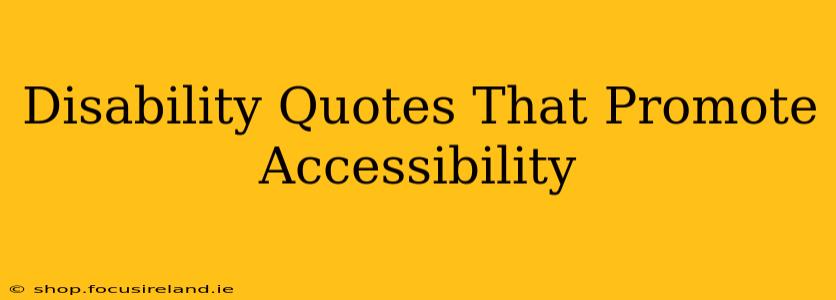Accessibility isn't just about ramps and braille; it's about creating a world where everyone feels welcome, valued, and empowered to participate fully. The following quotes, from disability advocates, artists, and thinkers, highlight the importance of accessibility and challenge us to build a more inclusive society. These aren't just inspirational words; they are a call to action. This post will explore impactful quotes and delve into what they mean for creating truly accessible environments.
What Does Accessibility Really Mean?
Before diving into the quotes, let's clarify what accessibility truly encompasses. It's far more than simply complying with regulations. True accessibility is about designing and building environments, both physical and digital, that are usable and enjoyable by people of all abilities. This includes:
- Physical Accessibility: Ramps, elevators, accessible restrooms, clear signage, and appropriate parking are all vital components.
- Digital Accessibility: Websites, apps, and software must be designed to be usable by people with visual, auditory, motor, and cognitive impairments. This involves using alt text for images, providing captions for videos, and ensuring keyboard navigation.
- Programmatic Accessibility: Events, workshops, and other programs should be designed to accommodate diverse needs, offering options like sign language interpreters, assistive listening devices, and alternative formats for materials.
- Attitudinal Accessibility: Perhaps the most crucial aspect, this refers to fostering a culture of respect, inclusion, and understanding towards individuals with disabilities. It's about challenging biases and creating a supportive environment where everyone feels welcome and valued.
Powerful Quotes on Disability and Accessibility
Here are some powerful quotes that underscore the importance of accessibility, followed by discussions of their significance:
"Disability is not an inability; it is a difference." — Unknown
This simple yet profound statement highlights the core principle of accessibility. It shifts the focus from limitations to diversity, emphasizing that disability is simply a variation in human experience, not a deficiency. Designing for accessibility, therefore, is not about "fixing" people but about designing for everyone.
"The measure of a society is how it treats its most vulnerable members." – Mahatma Gandhi
While not explicitly about disability, this quote speaks volumes about the moral imperative of creating an accessible society. People with disabilities are often among the most vulnerable members of society, and how we treat them is a reflection of our values and priorities. Accessibility is, therefore, a fundamental indicator of a just and compassionate society.
"We are all different. We all have different needs. Accessibility is not a special feature, it is a fundamental right." – Unknown
This statement rightly positions accessibility as a fundamental human right, not a luxury or an add-on. Just as everyone deserves clean water, food, and shelter, everyone also deserves equal access to participate in society.
Frequently Asked Questions (FAQs) about Accessibility
Here are some common questions about accessibility and their answers:
Q: What are some common accessibility barriers?
A: Common barriers include physical obstacles like steps and narrow doorways, inaccessible websites and apps, lack of assistive technologies, and discriminatory attitudes.
Q: Why is digital accessibility important?
A: In our increasingly digital world, access to information and services online is essential for full participation in society. Inaccessible websites and apps exclude individuals with disabilities from education, employment, healthcare, and many other aspects of life.
Q: How can I contribute to better accessibility?
A: You can contribute by advocating for accessibility legislation, supporting businesses that prioritize accessibility, learning about assistive technologies, and challenging ableist attitudes and language. Even small actions can make a big difference.
Q: What is the difference between inclusion and accessibility?
A: Accessibility refers to the design of environments and systems that are usable by people of all abilities. Inclusion, on the other hand, refers to the active participation and full integration of individuals with disabilities into society. Accessibility is a crucial prerequisite for inclusion, but inclusion requires more than just physical and digital access. It demands a culture of acceptance and respect.
Conclusion: Building a More Accessible World
The quotes above offer powerful reminders of the importance of accessibility and inclusion. By understanding the diverse needs of people with disabilities and actively working to remove barriers, we can build a more equitable, just, and inclusive world where everyone can participate fully. This requires not just policy changes but also a fundamental shift in attitudes and perspectives. Let's strive to create a world where the potential of every individual can be realized, regardless of ability.

